Content
- 1 What is infrared radiation
- 2 Influence of infrared radiation on the human body
- 3 Infrared treatment
- 4 The benefits of infrared rays
- 5 Applications of infrared radiation
- 6 The harm and consequences of exposure to infrared rays
- 7 Contraindications to the use of infrared radiation
- 8 How to avoid harmful effects of infrared radiation
- 9 First aid for heatstroke
- 10 Conclusion
Every day every person, one way or another, experiences the effects of infrared radiation. It is formed by electrical devices, but this is not the only source. The question is whether their constant impact is reflected in the human body. It is important to know what the benefits and harms of infrared radiation are.
What is infrared radiation
Infrared radiation is a form of heat energy. In another way, it is called "thermal radiation". It is produced by incandescent lamps, and also accounts for about half of the total radiation from the sun. It is electromagnetic radiation whose wavelength ranges from 0.74 microns to 2000 microns (which is 2 mm). It is impossible to see it with the naked eye; there are special devices for its registration.
This energy is of several types:
- near λ = 0.74-2.5 microns;
- average λ = 2.5-50 microns;
- far λ = 50-2000 microns.
Part of the mid-wave infrared radiation, namely from 7 to 14 microns, has properties that can positively affect the body, since this wavelength corresponds to the natural radiation of the human body.
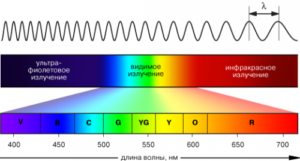
Influence of infrared radiation on the human body
The deliberate use of the properties of infrared rays benefits the human body. Here are examples of how they contribute to overall health benefits:
- The rays help to destroy disease-causing bacteria, thereby helping in the fight against colds.
- Infrared rays strengthen the immune system of children and adults.
- Also, doctors noted their benefits for the skin. By increasing blood flow, it is easier for the skin to receive the necessary substances, as a result of which it becomes more toned.
- The cosmetic effect of the rays for the skin is unlimited. Numerous studies show that they help heal skin conditions such as urticaria, psoriasis, dermatitis.
- The saturation of a closed space with infrared radiation helps to reduce the harm from dust to the human body.
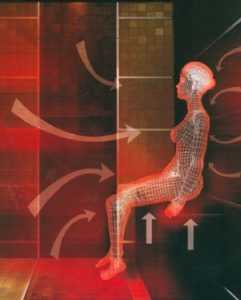
Infrared treatment
Thus, the benefits of infrared radiation for humans are achieved through the following mechanism:
- The heat coming from the rays triggers and accelerates biochemical reactions.
- First of all, the intensification of the processes of tissue regeneration begins, the network of blood vessels becomes wider, and the blood flow accelerates.
- As a result, the growth of healthy cells becomes more and more intensive, plus everything in the body begins to independently produce biologically active substances.
- All this lowers blood pressure due to better blood supply, thereby achieving muscle relaxation.
- Easy access of white blood cells to the foci of inflammation is provided. This leads to the strengthening of the immune system and the strengthening of the protective functions of the body in the fight against various diseases.
It is thanks to such special properties that a general strengthening effect for the body is achieved when treating with infrared rays.
In the course of treatment, both the entire body and some of its affected part can be exposed to radiation. The procedures can be performed up to 2 times a day, and the duration of the session is up to half an hour. The number of treatments depends on the needs of the patient. In order not to harm, during the sessions it is imperative to protect the eyes and the area around them from the effects of radiation. For this, various methods are used.
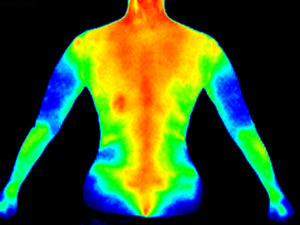
The benefits of infrared rays
The use of infrared rays in medicine has been scientifically proven. Improving overall human health, treating bacterial infections, lowering blood pressure, and relaxing muscles are not a complete list of the positive aspects of this amazing discovery.
Man, thanks to his perseverance, managed to find this amazing phenomenon useful in the most diverse and sometimes even unrelated spheres of his activity. Of course, behind all this is a careful study of the properties of the rays.
Applications of infrared radiation
It is used in the food industry, in physicochemical analysis, as well as in many other areas:
- With its help food is sterilized.
- In food production, rays are used not only for heat treatment of raw materials, but also to accelerate biochemical reactions in it.
- IR spectroscopy is a method of qualitative and quantitative analysis that allows you to establish the structure of many molecules, thanks to the special properties of infrared radiation.
- This technology is also used when checking banknotes for authenticity. When making banknotes, they are marked with special dyes that can only be seen with the help of infrared rays. It is very difficult for scammers to counterfeit such money.
- The properties of infrared rays are useful for use in night vision devices that read objects in the dark.
- The beams are used for remote control.
The previously mentioned use of infrared rays in medicine deserves special attention. However, there is still some harm from exposure to rays and contraindications to their use. Typically, the benefits and harms of infrared radiation for humans are determined by the wavelength.
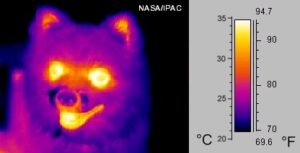
The harm and consequences of exposure to infrared rays
Strong exposure to infrared light harms, not benefits, the membrane of the eye, if, more precisely, dries it out. This occurs in very hot places.
Severe radiation also burns the skin. In this case, reddening of the skin occurs first. Occupational diseases of people who are often exposed to radiation in the workplace include just diseases, the symptoms of which are skin lesions. Neoplasms can also occur. The lighter consequences of harmful effects include dermatitis, which is also a difficult disease.
Contraindications to the use of infrared radiation
The use of infrared radiation as a therapeutic or prophylactic procedure should be avoided in the following cases:
- pregnancy and lactation;
- frequent bleeding;
- purulent processes;
- chronic diseases in the acute stage;
- blood diseases;
- oncological diseases.
The special properties of infrared radiation in these cases can cause harm to the body, which will aggravate existing diseases. Such treatment will definitely not bring benefits in the presence of such contraindications.
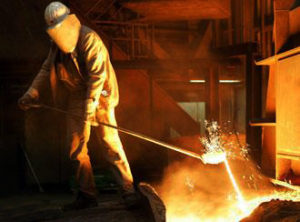
How to avoid harmful effects of infrared radiation
The pathogenic effect of infrared rays on the body occurs if they are shortwave. Household heaters are their main sources. Thus, in order to avoid harm to the body, one should either limit their use in everyday life as much as possible, or be as far away from the heat source as possible. In this case, household infrared radiation is very harmful. In the instructions attached to the safety heater kit, it must be indicated that its surface is covered with a material protected from heat, or that its radiation surface is less than 100 aboutC. They emit only long waves, the properties of which will not harm health, may even have some benefit.
Sources of harmful effects can be encountered in the workplace. These can be various technical ovens. To protect against the harmful properties of rays, workers are required to be provided with special clothing and equipment that will minimize harm.

First aid for heatstroke
If complications could not be avoided, a set of certain measures must be taken.
When providing first aid for heatstroke, the following steps should be taken.
- Call an ambulance.
- Move the victim to a cool place, ideally in the shade with fresh air.
- Make it easier for him to breathe by removing or unbuttoning clothing. Give validol.
- Put the victim in a horizontal position, lifting his legs.
- Give the victim 1 liter of water with a little salt added.
- Cool the person by wrapping him with a cold wet towel, apply ice to his forehead.
- In case of loss of consciousness, it is necessary to give the victim a sniff of ammonia.
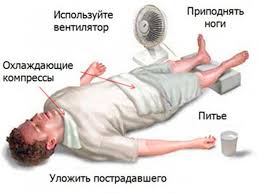
Conclusion
Thus, the benefits and harms of infrared radiation for humans depend only on how to correctly use the rays. Like any thing of a technogenic nature, infrared rays have their pros and cons. Over time, mankind finds their properties more and more useful applications, opening up new possibilities, while not forgetting about their possible harmful effects. Fortunately, there are not so many emitting objects in everyday life that can cause irreparable harm to a person.

